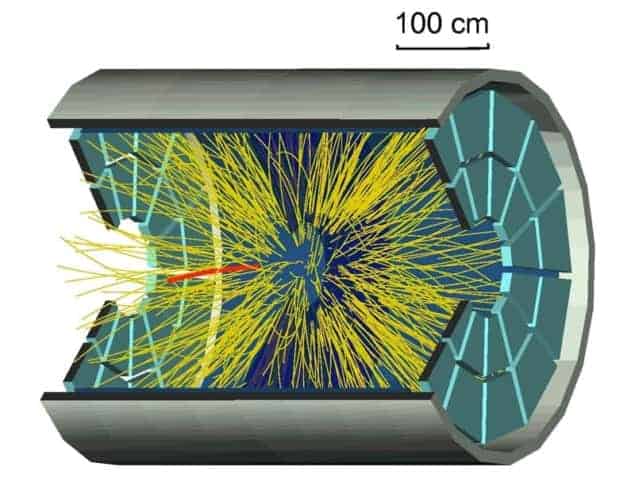
Physicists at the Relativistic Heavy Ion Collider (RHIC) in New York say they have created nuclei of antihelium-4 for the first time – the heaviest antimatter particles ever seen on Earth.
Antimatter nuclei are built from antiprotons and antineutrons but of all the various two- and three-quark combinations that can arise in particle collisions, it is rare that multiple antiprotons and antineutrons appear near enough to one another that they bind into anti-nuclei. Although the first antiprotons and antineutrons were discovered in the 1950s, the construction of heavier nuclei has been extremely taxing as each additional anti-nucleon makes the anti-nucleus 1000 times less likely to appear in a particle collision. Up until now, the largest anti-nuclei observed were capped at three anti-nucleons.
But RHIC is an experiment that can generate the right conditions for the formation of antimatter by smashing gold ions together in an effort to simulate conditions shortly after the Big Bang. Two antihelium nuclei seemed to have turned up in this hot soup of particles in 2007, their signatures appearing in collisions recorded by RHIC’s STAR detector at an energy of 62 giga-electron-volts (GeV) per nucleon pair. However, as Peter Braun-Munzinger of the GSI Helmholtz Centre for Heavy Ion Research in Germany, who was not involved in this latest research, points out: “If you have something very rare, you would like to measure it twice.”
Last year, the STAR collaboration installed an advanced time-of-flight detector that can help to spot unconventional particles among all the debris. The STAR detector, sitting inside a solenoid magnet, enables researchers to determine the masses and charges of new particles by their speeds and deflections in the presence of the magnetic field. From a catalogue of about a billion of collisions at energies of 200 GeV and 62 GeV, a total of 18 revealed themselves as antihelium-4, with masses of 3.73 GeV. The researchers have published their findings on the arXiv preprint server but were unavailable to comment on the work.
250,000 times hotter than the Sun
The rate at which the antihelium-4 was produced at RHIC supports the view that there are two ways to think about how anti-nuclei form. On the system level, the mass of the nucleus is understood in terms of energy and its probability of showing up depends on the system’s temperature – in RHIC, that’s over 250,000 times the temperature of the Sun’s core. But, on the level of individual particles, the formation of antihelium-4 relies on the odds that the right nucleons are created in the collision, near enough to one another so that they clump together as a nucleus.
According to the STAR collaboration, the amount of energy needed to add extra nucleons makes it unlikely that larger stable anti-nuclei will be found in the foreseeable future. No known 5-nucleon particle is stable, so experiments will need to jump to something like antilithium-6 – nearly a million times less likely to turn up than antihelium-4.
The low rate at which antihelium-4 is produced at RHIC makes it unlikely that the Alpha Magnetic Spectrometer (AMS), scheduled for launch to the International Space Station next month, will detect them – at least from ordinary nuclear reactions.. The AMS will measure cosmic rays in space, before they can get torn apart in Earth’s atmosphere. From these interstellar and intergalactic particles, the AMS collaboration hopes to solve mysteries such as why antimatter appears to be largely missing in the universe. “If we find antihelium-4 in the cosmic rays, it is definitely coming from a fusion process inside an anti-star,” says AMS deputy spokesperson Roberto Battiston. Currently, anti-stars aren’t believed to exist.
Meanwhile, researchers at the ALICE experiment on CERN’s Large Hadron Collider have revealed that they also detected antihelium-4 in collisions of lead ions last November. Braun-Munzinger, a member of the ALICE team, says that these results should appear on arXiv in a week or so. He says that he has not relinquished hope of finding heavier antimatter but whatever happens he is looking forward to finding new exotic anti-nuclei, in which the anti-up and anti-down quarks of the antiprotons and antineutrons are replaced by rarer antiquarks.



